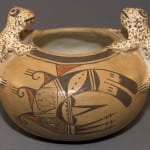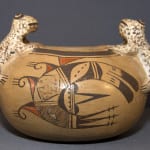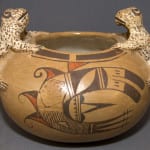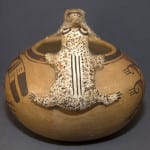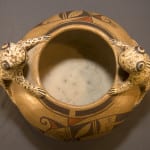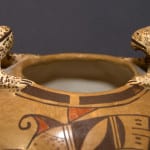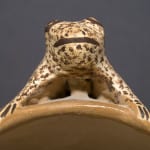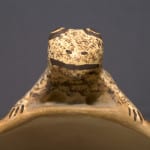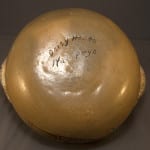The bowl of this pot is entirely Hopi. The frogs on this pot are entirely Zuni; it’s a strange hybrid. The pot reminds me of Dr. Seuss’ book If I Ran A Zoo, which featured creatures with elephant heads on giraffe bodies, but with spare feet. The surprising forms of those creatures and this pot make me smile.
Both frogs are 3” long from tail to snout. They have slightly different leg spans. The larger frog has a leg span of 2.625” in the front and 3.75” in the rear. He has a rounded face that is tilted so that he is looking high in the sky. The smaller frog has a leg span of 2.375” in the front and 3.375” in the rear. His face is thinner and his head is held so he is looking directly across the pot at the larger frog. The variance in head size and orientation adds interest and an air of whimsy. The two Zuni frogs are perched on the rim of a totally Hopi-Tewa pot, which is an odd amalgam. This composition is characteristic of Zuni pots, but virtually unknown at Hopi. The rear feet on both frogs have “fingers” that are painted on the Zuni slipped frogs and extend onto the surface of the Hopi pot.
The construction and painting of the pot is exceptionally and carefully done. For example, each frog has a pillar of clay that bridges between its chest and the surface of the pot to support and join the appliqué frogs onto the bowl. The Zuni frogs are slipped with white, chalky clay and much of their surface has brownish-red stipple painting. This stippling continues underneath the frogs and, in one case, includes the supportive pillar. The bowl under the frogs has the white Zuni slip over the Hopi burnished finish used on the rest of the bowl. The frogs are carefully painted with protruding concentric circle eyes, a simple line for the mouths, and two stripes on their backs.
The bowl has the typical Nampeyo wide-over-thin framing lines around the mouth, although the Zuni frogs interrupt these lines. Notice that Daisy, unlike her grandmother’s general style, has been deliberate about including the traditional line break. The Sikyatki Revival designs on both sides of the bowl are identical, except that one side has four dashes in an ovoid-shaped space near the apex of the design, and on the other side the four dashes are absent. The basic circular motif of the Sikyatki design is classic Nampeyo (See Kramer 1996:187). One end of this design might be interpreted as two avian tail feathers, and the other more delicate end features elements that might represent three nakwakwusi, or prayer feathers. At the interior curve of the overall design, Daisy has added another classic Nampeyo motif, which Kramer labels a “clown face” (1996:188). Attached to the exterior curve of the design are three elements that end in curved lines and incorporate red paint. These red areas, and a triangular red area that connects the thin framing line with the circular design, are the only areas of red on the pot. Usually, I would call the design on this pot “monochromatic,” except for these small areas of red, but the addition of the white-slipped frogs with their brownish-red stippling gives the overall pot a substantial variation of color, form, and texture. The conception of this pot is both striking and unique. It is not a pot you can look at without smiling—even on a bad day.
Of all the Hopi and Hopi-Tewa potters represented in this collection, the life of Daisy Hooee Nampeyo (1905/6 to 1994) may be the most unusual. More than any pot in the collection, this pot reflects the life of its maker.
Like her famous grandmother, Daisy was afflicted with eye trouble. In 1924, Anita Baldwin, a wealthy California business woman and philanthropist, set up an elaborate tent compound in Annie Healing’s peach orchard and spent the summer studying Hopi culture. With Annie’s permission, Ms. Baldwin brought the teenage Daisy to California and arranged for the needed cataract surgery, which was successful. For several years Daisy lived on the Baldwin estate just outside Los Angeles, and returned to Hopi during the summers. Impressed by Daisy’s artistic talent, Ms. Baldwin enrolled her in L’Ecole des Beaux Arts in Paris, where she studied European Art, learned French, and saw Lindbergh land in 1927. Later, Ms. Baldwin accompanied Daisy on a European tour to study art in Spain, Switzerland, Germany, Italy, Austria, North African, Finland and Russia. When Daisy was about 25 years old, she chose to return to Hopi, married a Hopi man (Neil Naha), and had three children with him. During this time, she painted pottery formed by her grandmother and made her own pottery. (There is a photograph of her and Nampeyo making pottery, on file.) (The early Daisy tobacco leaf identification mark in the photograph is also on the bottoms of 2007-07 and 2007-08 in this collection.)
Daisy’s marriage became difficult, however, and she and Naha divorced. Soon after, she met a Zuni jeweler (Leo Poblano) and moved to Zuni where she lived until her death in 1994. Leo was also a firefighter, and in the late 1950s he was killed while fighting a forest fire. Later, Daisy married another Zuni jeweler, Sydney Hooee, and he was her last husband. In the 1960s, Daisy helped revive the art of pottery making at Zuni by starting a Zuni-style ceramics class at the reservation high school. (For a pot made by this program, see 2003-06.) Daisy lived in many worlds. (Biographical information is from the Blairs 1999:183-184, 194-198, and Fowler 1977.)
As her older sister Rachel aged, Daisy frequently traveled back to Hopi to help Rachel with her pottery. (See 1989-06.) Throughout her life, Daisy made Nampeyo-like Hopi pots using Hopi clay. Sometimes she made Zuni-style pottery. (See 2007-02 and 2020-05 for examples.) Pot 2011-13 is the only pot I know of that combines both pottery traditions.
(For a complete list of the Daisy pots in the collection, please see the Index of Artists.)
Al Hayes, from whom I bought pot 2011-13, sent me an email and photograph of this pot on 12/24/10:
Picked this up from a recent auction, and it’s the kind of thing that gives me goose bumps. I’ve always felt that Daisy Hooee was one of the most important potters from any Pueblo…. Of all the pieces (by Daisy) we’ve ever seen, this proves to use how firmly she had her feet planted in both Pueblos (Hopi and Zuni)….Can’t tell if she went so far as to use Zuni clay for the frogs, but there’s no question about the slip. (The slip on the frogs) even has a different gritty texture from the unpolished interior (of the bowl). [Email on file.]
On their website, Carol and Al added:
We think this is one of the most surprising and important pieces we’ve ever owned. Here, Daisy put Hopi pottery and Zuni pottery on the same jar—something only she could have done. The bowl is in the pure Nampeyo tradition, made with polished Hopi clay. The appliqué frogs are made the Zuni way, with Zuni slip. Since the slip is intact, we cannot tell whether she made them with Zuni clay, but if they weren’t attached to the bowl, we’d easily identify them as Zuni. This jar shows how completely Daisy became both Hopi and Zuni, and we know of no other piece with a pottery marriage like it. A pencil note on the bottom says Jan 76 with a [$] price, and that price helps confirm the date. At that time, her fame and her prices were escalating. [Full text on file.]
There are two other pots in the collection that depict frogs and seem to be a crossover between Zuni and Hopi, though 2011-13 is the only Hopi pot I have seen with appliqué frogs. First is a bowl formed by Daisy and painted by Shirley Benn, her granddaughter (2010-25). As noted in its catalog entry, that pot is made of Zuni clay, has typical Hopi motifs on the exterior, and a Zuni design of frogs and tadpoles painted on the inside. Thus, like pot 2011-13, pot 2010-25 demonstrates Daisy and her granddaughter’s attachment to both Hopi and Zuni traditions. Second, a Hopi-made stepped bowl by Maya David (2010-26) has frogs painted on the inside. In a phone call, Maya told me her pot honored her father’s heritage and was inspired by a pot in the collection of the Museum of Northern Arizona.


